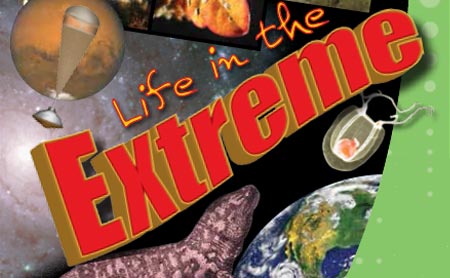
With its theme of “Life in the Extreme,” the 10-day festival tempts inquisitive minds to explore more than 80 free events that delve into intriguing mysteries of life on Earth.
It all kicks off at 7 p.m. Friday, Sept. 20, at NAU’s Ardrey Auditorium, with a keynote presentation by Steve Squyres, lead scientist for the Mars Exploration Rovers. Squyres will present the latest data gathered from millions of miles away and discuss the search for evidence of more Earth-like conditions.
The ever-popular Mountain Campus Science and Engineering Day takes place from 1 to 4 p.m. Saturday, Sept. 21, and encourages interest in the sciences through hands-on exploration. Led by NAU faculty and students, the event will feature an earthquake simulation, solar equipment built by NAU undergrads for use by developing countries, physics and chemistry magic shows, campus laboratory tours and much, much more.
A series of lectures at Cline Library will explore some of the most extreme organisms on our planet. Hear what scientists have to say about such topics as the reality of a zombie apocalypse, the effectiveness of hot water in killing off bacteria, and the significance of our actions within the greater universe.
The Flagstaff Festival of Science runs from Sept. 20-29. All events are free and open to the public. For a complete schedule, to print out the passport brochure or to make reservations for limited events, visit the festival’s website.
Festival Highlights
Featuring on-campus events and NAU experts
Friday, Sept. 20
Shoemaker Keynote Presentation: Steve Squyres
7 p.m. NAU Ardrey Auditorium
Explorer, geologist and Mars rover boss Steve Squyers shares amazing discoveries, up-to-the-minute images and extraordinary findings from nail-biting Mars rover missions.
Campus Sky Viewing
Sept. 20-22 and Sept. 27-29
7:30 to 10 p.m. NAU Campus Observatory
View the universe up close and personal through the 20-inch Barry Lutz Telescope for Education and Training.
Saturday, Sept. 21
Mountain Campus Science and Engineering Day
1 to 4 p.m. High Country Conference Center, Wettaw and the Physical Sciences Buildings
Volcanoes, earthquakes, rockets, telescopes and bugs! All ages are welcome to come have fun with discoveries around every corner as professors and students demonstrate the tools they use to explore our world.
Monday, Sept. 23
Bats!
4 p.m., Lowell Observatory
There are 28 different types of bats living in northern Arizona’s caves, canyons, deserts and forests. NAU forestry professor Carol Chambers explains how these delicate night creatures that can sleep upside down use their radar to eat hundreds of insects each night.
Extreme Pathogens: Can the Zombie Apocalypse Really Happen?
6:30 p.m. NAU Cline Library
While movies and TV shows provide great fodder for the imagination, NAU adjunct research faculty member and biology doctoral student David Engelthaler, director of TGen North, discusses how microbes may already be ahead of Hollywood.
Chemicals Impacting Wildlife
6:30 p.m., Museum of Northern Arizona
Human-made chemicals find many routes into our environment, and some of these compounds affect wildlife. NAU biology professor Catherine Propper explains where these chemicals are coming from, how they are impacting development and reproduction and what this may mean for wildlife and human health.
Tuesday, Sept. 24
The Mars Polar Night
5 p.m., Lowell Observatory
During the Martian winter, a large part of the polar region remains in darkness for months and temperatures drop to nearly 200 degrees below zero. NAU adjunct astrophysics faculty member Timothy Titus of the U.S. Geological Survey explains what happens when the sun finally rises.
Wednesday, Sept. 25
Extremes in Marine Life: Why Males and Females Look Different (Or Not)
5 p.m., Lowell Observatory
Many animal species exhibit extreme differences in appearance between males and females. NAU biology professor Stephen Shuster explains how variation in fertility can cause males and females to look the same or very different.
From the Swab to the Cloud: Advances Toward Understanding our Microbial World
6:30 p.m., NAU Cline Library
Bacteria make up the vast majority of life on Earth. NAU assistant professor of biology Greg Caporaso discusses microbial life in extreme environments—including hot springs, the driest deserts and the vertebrate gut.
Thursday, Sept. 26
The Asteroid 4 Vesta and Extremes of the Main Asteroid Belt
6:30 p.m., Museum of Northern Arizona
The ion-propulsion drive spacecraft Dawn spent one Earth-year in orbit around the second largest asteroid in the main Asteroid Belt. NAU adjunct astrophysics faculty member Timothy Titus shares the discoveries of this journey to an extreme environment.
A Thousand Invisible Cords; From Genes to Ecosystems
6:30 p.m., NAU Cline Library
Viewing this eco-documentary, featuring NAU Regents’ Professor Tom Whitham, may change how you see the world. No longer do we consider species as isolated members of ecosystems.
A complete schedule of events is online.



